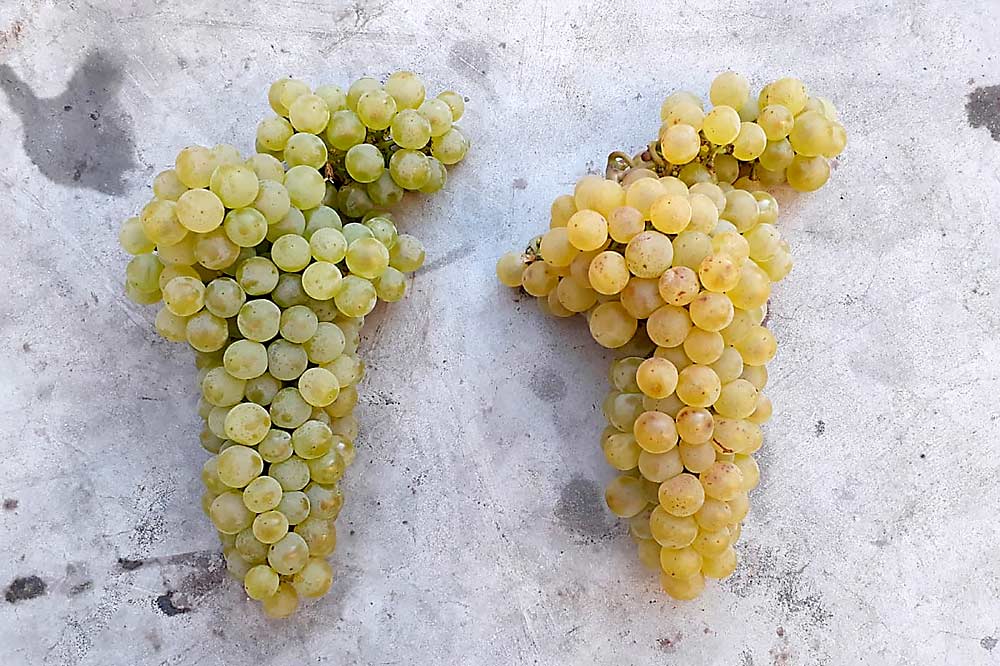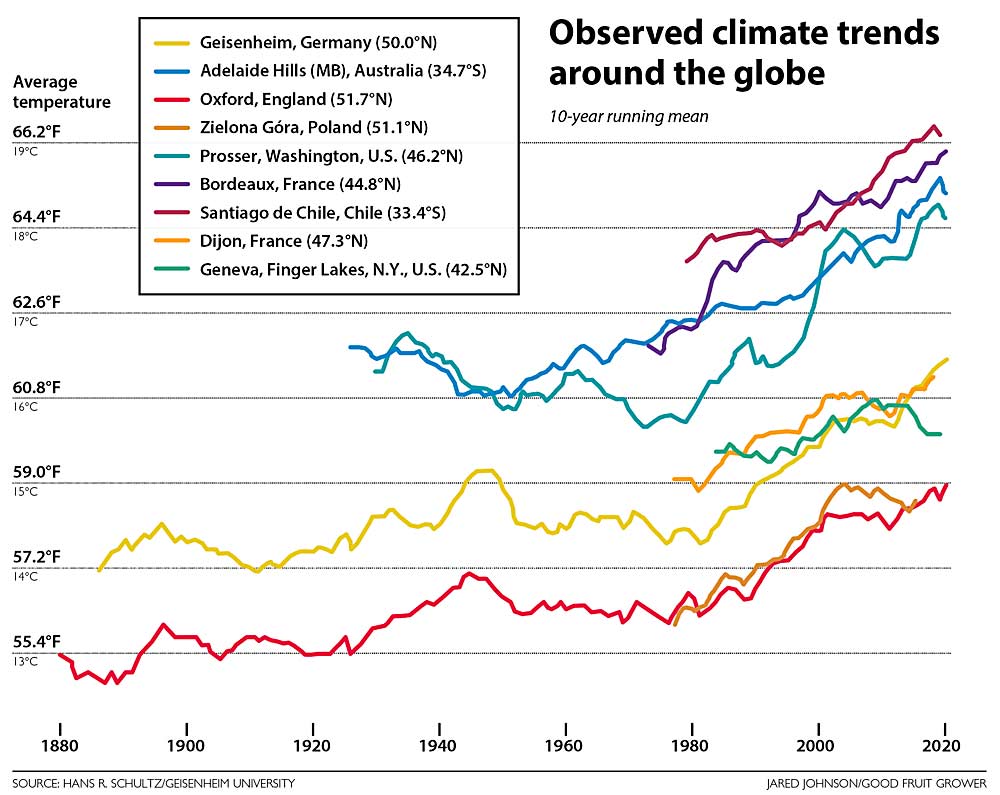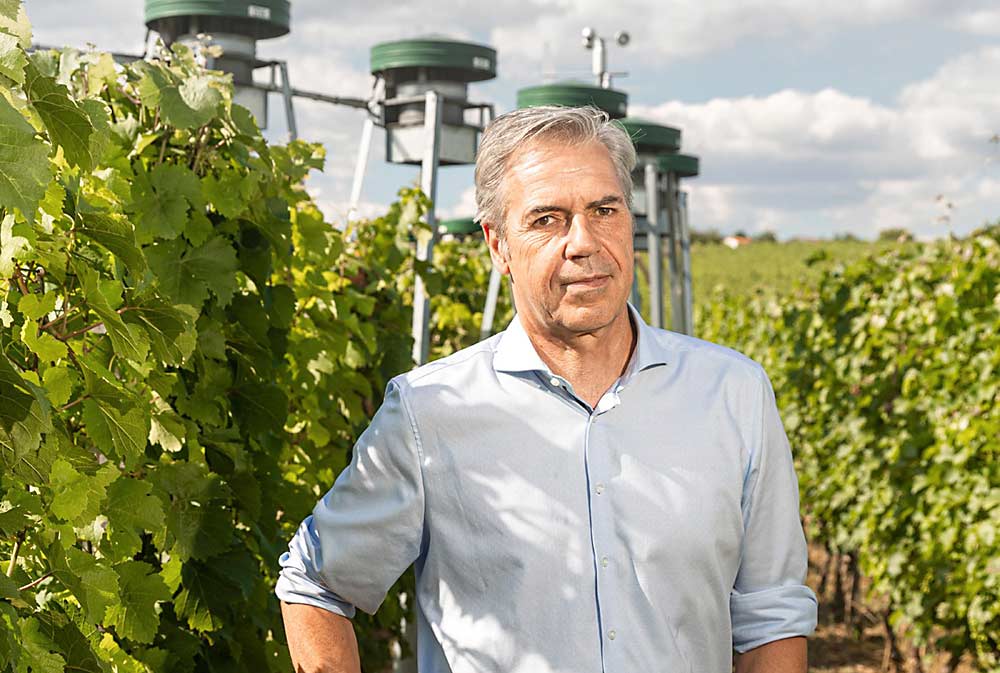
Grape growers around the world are feeling the effects of climate change, and while today’s variable weather patterns may bring excellent crops and exceptional vintages every now and then, experts say growers will have to adapt to continue producing high-quality berries that yield the wines consumers expect.
“I believe that recent harvests of Riesling were some of our best harvests ever, and that only happened because of climate change. That is for sure. But the problem at the same time is that the nicer the wine, the more difficult it is for the plant,” said Dominik Sona, a vineyard manager and cellar master in Germany and, since 2010, general manager/winemaker at Koehler-Ruprecht.
Sona was one of two key European speakers at B.E.V. NY, Cornell University’s annual education conference for New York state’s grape and wine industry, which was held in March. He shared that as weather has become more variable, European growers have begun re-evaluating their agricultural practices so they can keep the industry going for the next generation and beyond.
Sona’s comments followed a sweeping overview of the issue from Hans R. Schultz, president of Geisenheim University in Germany and a leading expert on viticulture and the impacts of climate change. Schultz described the degree to which climate change has already altered temperature, water availability and soils, all of which are vital for wine grape production.
Climate change and effects
Schultz described overall increasing temperatures in grape-growing regions around the world during the growing season. In Geisenheim, which is at 50 degrees north latitude (50°N), the temperature has increased by about 4 degrees Fahrenheit over the last 40 years, so today the average in Geisenheim is similar to that experienced back in the 1980s in Bordeaux, France, which is located about 400 miles south. Bordeaux has had its own temperature rise over the past 40 years and is now about 4 degrees above its 1980s average. Similar increases have also occurred in other regions, including Prosser, Washington, Adelaide Hills, Australia, and Oxford, England, which is now producing sparkling wines.

And as air temperature increases, he added, so does soil temperature. Since 1980, Geisenheim soil temperatures at 1 meter in depth have increased by 4.5–5.4 degrees Fahrenheit in the spring, 1.8 degrees in the fall and an astonishing 7.2–8.1 degrees on average over the three months of summer.
“That’s huge,” Schultz said. “We don’t know what is happening underneath our feet, in terms of organic material degradation, nitrogen release and things like this, so we really need to focus on the soil a lot more.”
Aboveground, increasing temperatures result in more evapotranspiration as well as more precipitation, but different sites may get more of one than the other. This throws off the so-called water balance, which can lead to water-management issues, he said. In Geisenheim, for example, evapotranspiration has been outweighing precipitation and draining soil water reserves.
As a grower and winemaker rather than a scientist, Sona said he is especially interested in the weather details that affect his vines, such as rainfall timing, periods of drought, heat waves and number of sunshine hours, and also how specific varieties fare under changing conditions. One thing that has become apparent recently is that Chardonnay is much less sensitive to changing weather patterns than Riesling. While Chardonnay has shown little change in picking time, Brix or yield, the picking time for Riesling between 2015 and 2020 ranged from Sept. 21 to Oct. 18.
“The same thing happened with Brix, which went from 20.75 to 24.25,” Sona said. Yield also showed a considerable variation, ranging from 4–7.9 tons per acre. “Riesling is ‘home’ to us, so this is basically the problem,” he said.
While Chardonnay vintages from 2015–2020 taste quite similar, Riesling vintages have varied from year to year, according to Sona.
“The customer needs to be open to Riesling tasting much different from last year, and (realize that) next year it will be tasting different than this year,” he said.

Today and tomorrow
To adjust to changing weather patterns, Sona said Koehler-Ruprecht vineyards are using several approaches, including:
—Soil management: The vineyards make their own compost, adding stone powder and fermented biochar (which he called terra preta) “to build up the humus complex and also the water-holding capacity,” he said. In addition, they sometimes wait two to six years before replanting an old vineyard, which reduces soil compaction from farm equipment in the area.
—Lower canopy: Because sunshine hours have risen considerably over the past decade — 2,000-plus hours per year compared to the 30-year average of 1,639 hours — and precipitation during the growing season is decreasing, new vineyards are managed with a smaller canopy. “We need less leaves for the photosynthesis; and the less leaves we have, the less water we need as well,” he said.
—Wider canopy on top: Workers remove laterals in the grape zone to increase air movement and trim the canopy two or three times, “but as late as possible” and in such a way that the top of the canopy remains wide to provide shade and prevent too much evaporation from occurring.
—Planting decisions: Total acidity has decreased in Riesling grapes, dropping from 8 grams in the 1990s — 4 grams tartaric and 4 grams malic — to 6 grams of tartaric and no malic today. One of the ways the vineyard is trying to counter that is by planting a historical variety called Gelber Orleans, or Yellow Orleans. They hope to use this late-ripening, high-acid and low-sugar variety as a blending crop to boost acidity in Riesling. The vineyards are also working with more vigorous rootstocks and looking into clones that have smaller bunches and looser berries.
On the research side, Schultz said various climate models and the unique Geisenheim FACE (Free Air Carbon Dioxide Enrichment) facility, which is cultivating Riesling and Cabernet Sauvignon under the 20-percent-higher carbon dioxide levels anticipated by 2050, provide glimpses into future conditions and their impacts on vineyards. Under conditions with 20 percent higher carbon dioxide in the FACE vineyard, grape berry moth had one additional generation per year, and its larvae were 25 percent heavier.
“This type of result was completely unexpected, but we now can give a hint to the industry and say, ‘OK, if you want to use the dispersal of pheromone systems for this type of insect, you’ll need new products by the year 2050 that at least are capable of controlling one additional generation,’” Schultz said.
Other FACE experiments have shown that elevated carbon dioxide concentration also alters bunch weight and cluster length in Riesling. “The anatomy changes: the clusters become longer and get much heavier, (but) cluster compactness doesn’t change,” he said. “And, I’m pretty sure there are certainly more surprises ahead.”
Both Schultz and Sona agreed that growers need to begin to think forward if they hope to continue producing grapes for years to come. “We cannot continue every year to do what we did in the 1990s. That is impossible,” Sona said.
Schultz likewise sees climate change as a hurdle rather than a brick wall.
“Agriculture is not a coral reef. We can adapt in a lot of ways — we can adapt canopy structure, delay maturity, change row directions to decrease the impact of solar radiation and a lot of different things,” he said. “I’m pretty optimistic.”
—by Leslie Mertz






Leave A Comment